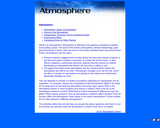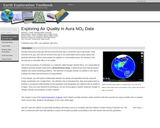
Students learn about the composition of the atmosphere and how atmospheric conditions affect humans.
- Subject:
- Earth Science
- Science
- Material Type:
- Activity/Lab
- Provider:
- ASPIRE
- Author:
- ASPIRE
- Date Added:
- 02/26/2019

Students learn about the composition of the atmosphere and how atmospheric conditions affect humans.

Students will learn about the structure and composition of the atmosphere. Students will also track weather conditions for four days. and relate their observations to atmospheric characteristics.

The AtmosphereGiving us credit when you use our content and technology is not just important for legal reasons. When you provide attribution to CK-12 Foundation, you support the ability of our non-profit organization to make great educational experiences available to students around the world.Our Creative Commons License welcomes you to use our content and technology when you give us attribution. If you have any questions about our policies, contact us at support@ck12.org

In this lesson, students will look at the different layers of the atmosphere to determine how the atmosphere helps sustain life on Earth. Students will model the layers of the atmosphere through an interactive lab that looks at characteristics of the atmosphere by analyzing the atmospheric temperature profile and the special features that can be found in each layer.

Atmospheric LayersGiving us credit when you use our content and technology is not just important for legal reasons. When you provide attribution to CK-12 Foundation, you support the ability of our non-profit organization to make great educational experiences available to students around the world.Our Creative Commons License welcomes you to use our content and technology when you give us attribution. If you have any questions about our policies, contact us at support@ck12.org

In this chapter, students will explore relationships between air quality and population density using the image visualization tool, Google Earth. You will learn how to download NO2 data and analyze them to develop a conceptual understanding of how population and topography can influence the air quality of a region. Once you have learned the techniques, you are encouraged to explore seasonal changes in nitrogen dioxide concentrations at other locations. This chapter is part of the Earth Exploration Toolbook (EET). Each EET chapter provides teachers and/or students with direct practice for using scientific tools to analyze Earth science data. Students should begin on the Case Study page.

The activities in this guide will help students understand variations in environmental parameters by examining connections among different phenomena measured on local, regional, and global scales.

Students will differentiate between the good and bad ozone, locate the position in the atmosphere where the good and bad ozone reside, plot monthly ozone data, and understand the ground level ozone effects on humans and plants.

Students will examine NASA images and images from the Neumayer Antarctic Station to graph and investigate atmospheric ozone.

This science update discusses the increase in hurricane activity in the mid 1990s and the proposed reasons for the increase.

This online article describes hurricanes, how they form, and factors that cause them to intensify and/or weaken.

Students will visualize how combustion reactions occur and how the burning of fossil fuels produces CO2.

Students will be introduced to the criteria pollutants and will work in groups to make cartoon booklets demonstrating the formation of ground-level ozone and the destruction of stratospheric ozone.

Students check for the presence and relative amounts of ozone in the air using Schoenbein strips they make with filter paper, cornstarch, and potassium iodide.

Students will understand the concept of parts per million and billion by diluting a solution of food coloring and water. They will then correlate their findings with concentrations of various gasses in the atmosphere

In this lesson, students learn about air. Through a variety of hands-on experiences presented as stations in the classroom, students will discover properties of air, including that air has volume, mass, and pressure; that it is compressible; and that it expands when heated. They will also learn about the major molecular components of our atmosphere (nitrogen, oxygen, argon), the four layers of our atmosphere, and that air contains water vapor. Note: The videos referenced in the lesson narrative are no longer available online, but the station activities are not dependent on the content in the video.

Students will learn where they can find the daily Air Quality Index (AQI) forecast and how to interpret it. They will also identify seasonal patterns for ozone and particulate matter in their region, and learn some of the reasons behind those patterns.

Students learn about greenhouse gases in this brief animated video.

Students investigate the interconnectedness of the Earth's water reservoirs by learning about the hydrosphere. They then discuss ways in which humans are connected to and alter those reservoirs, especially the ocean.

This article offers suggestions for several demonstrations pertinent to the atmosphere, pollution, and global climate change.